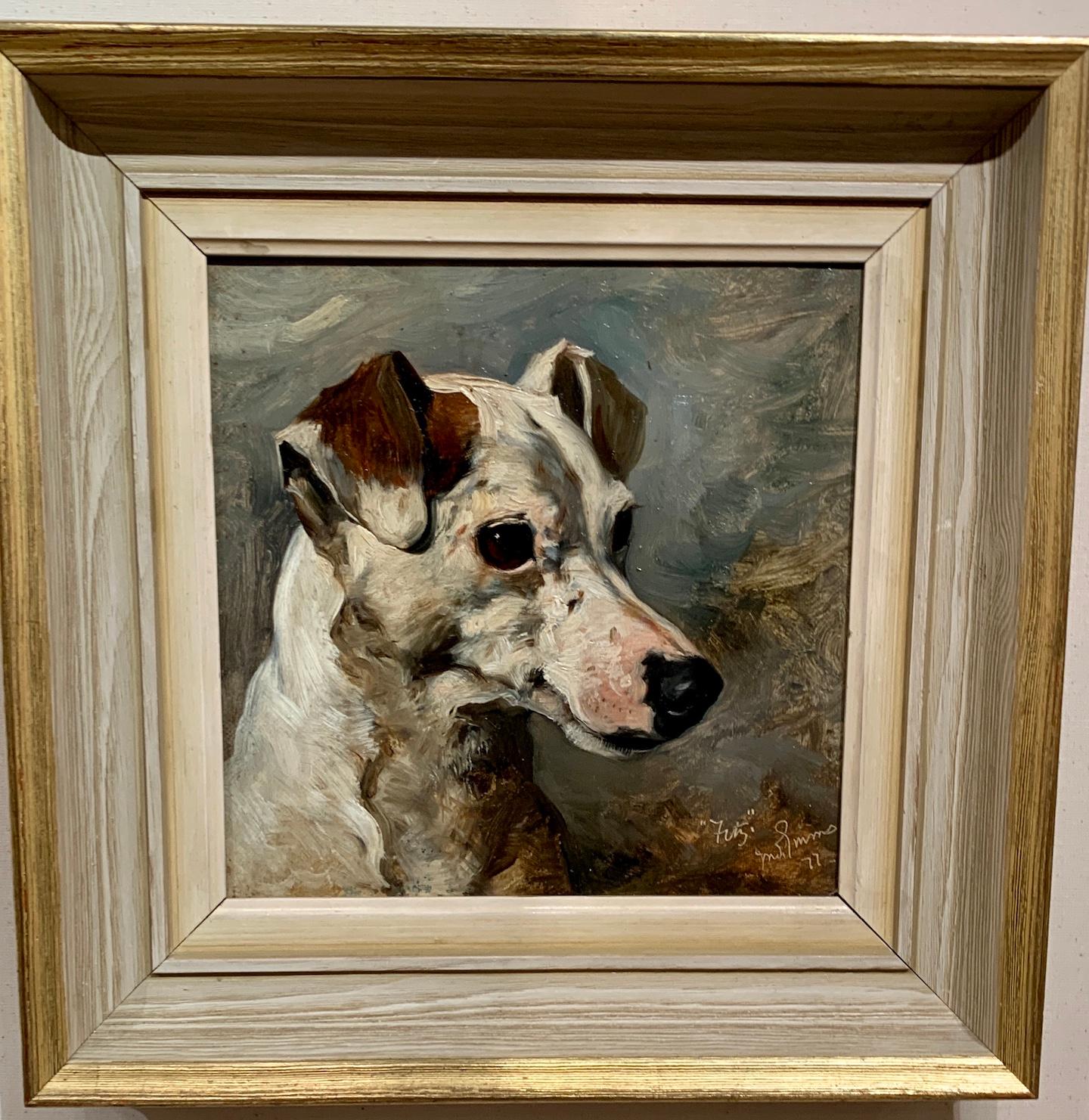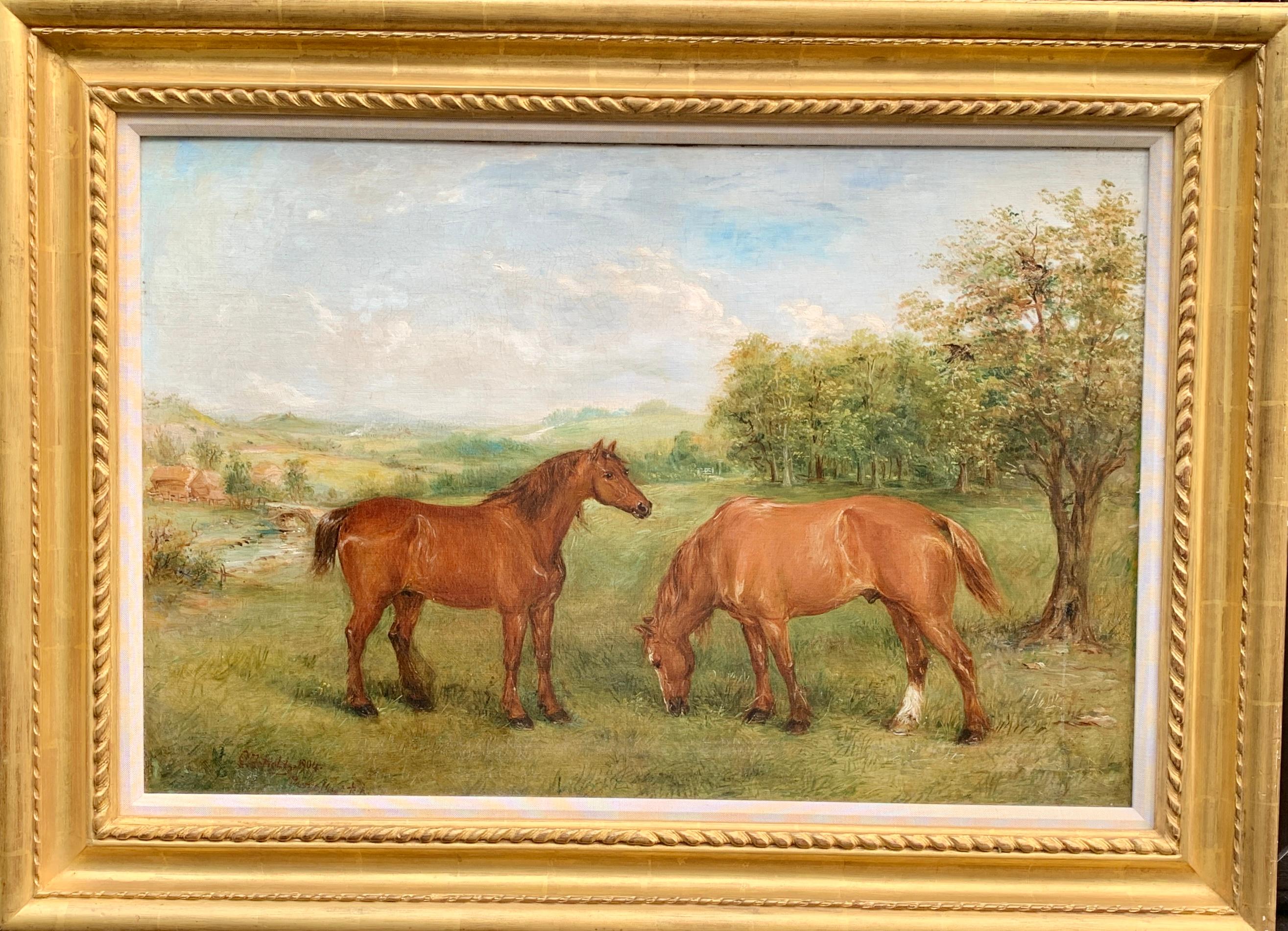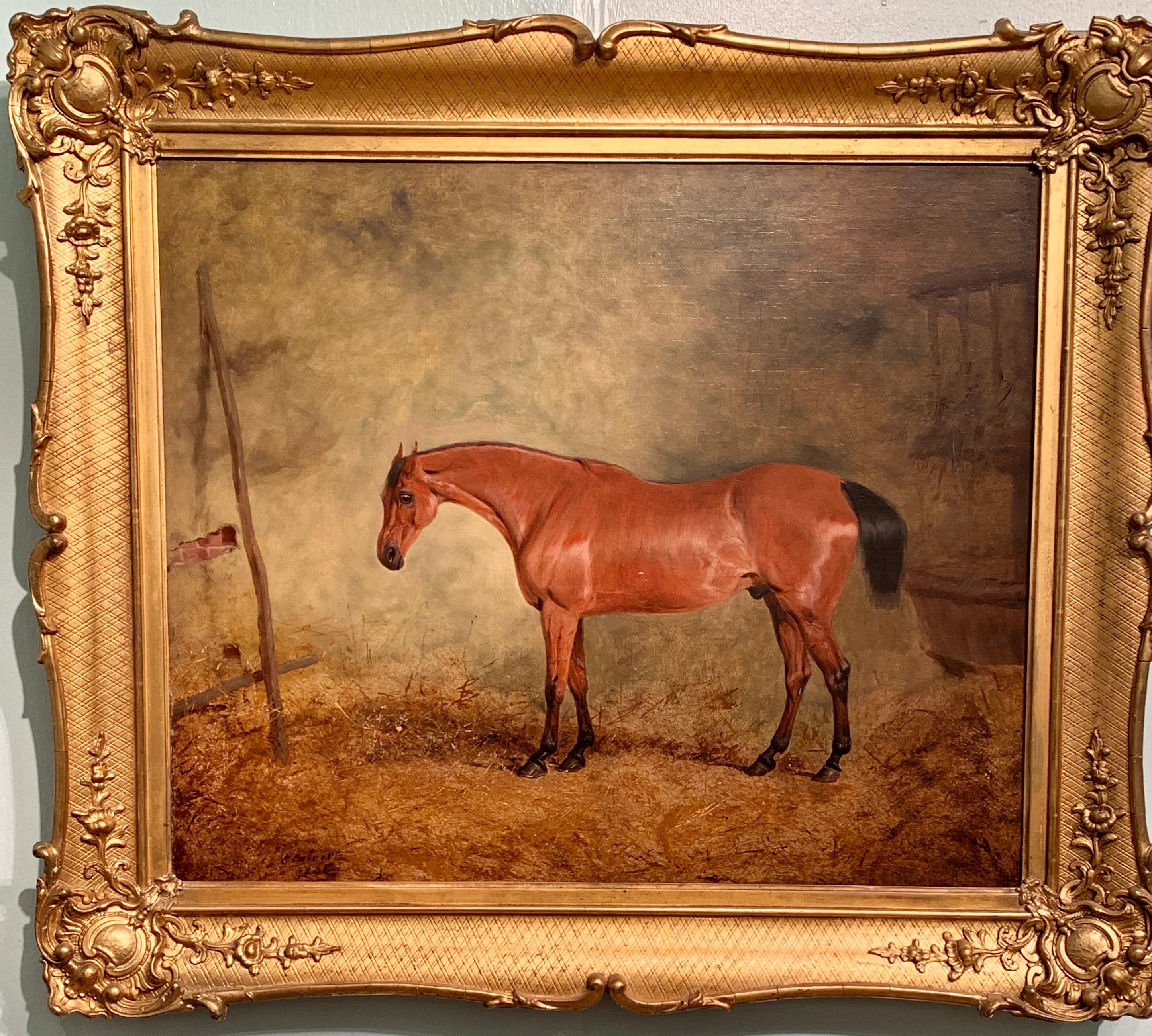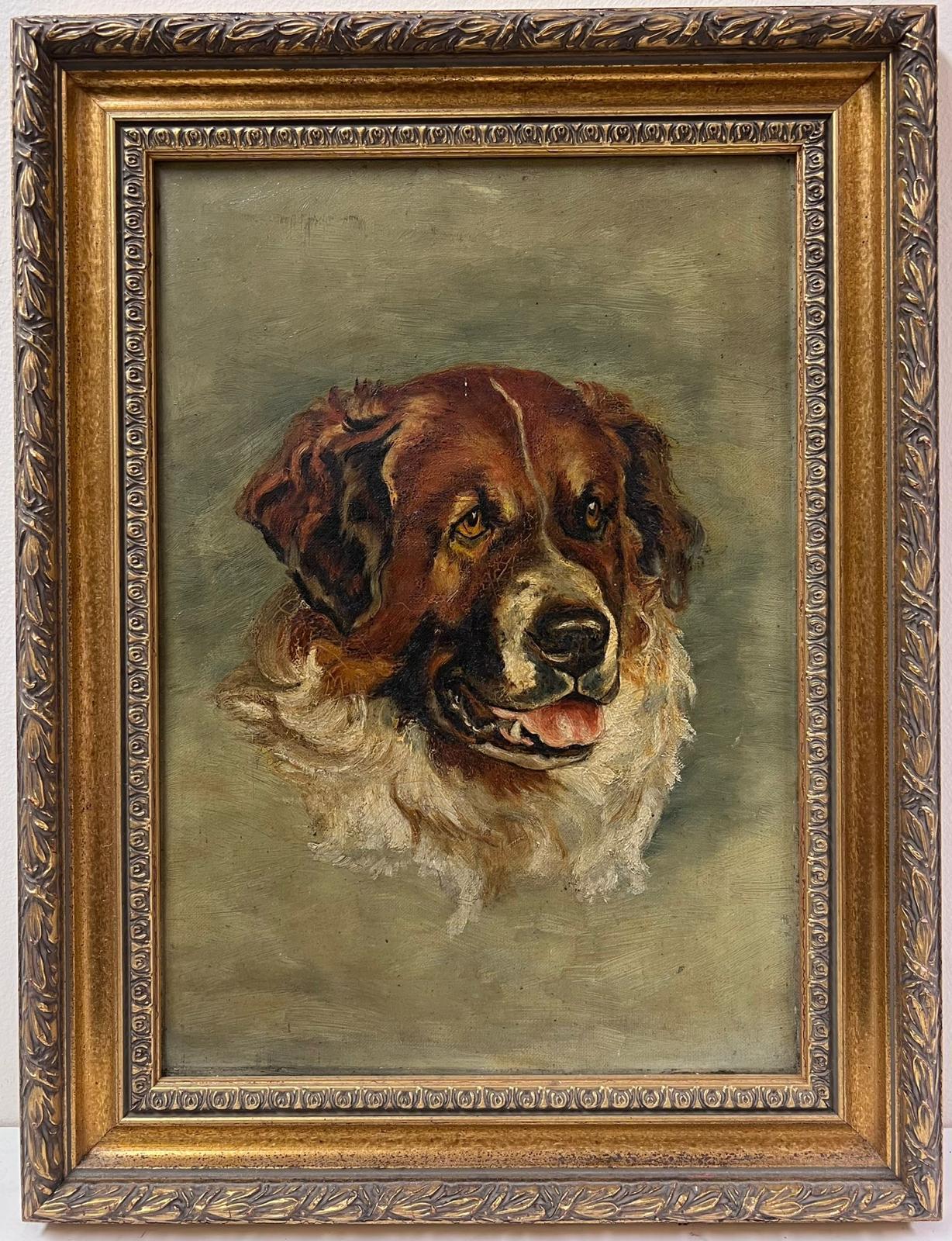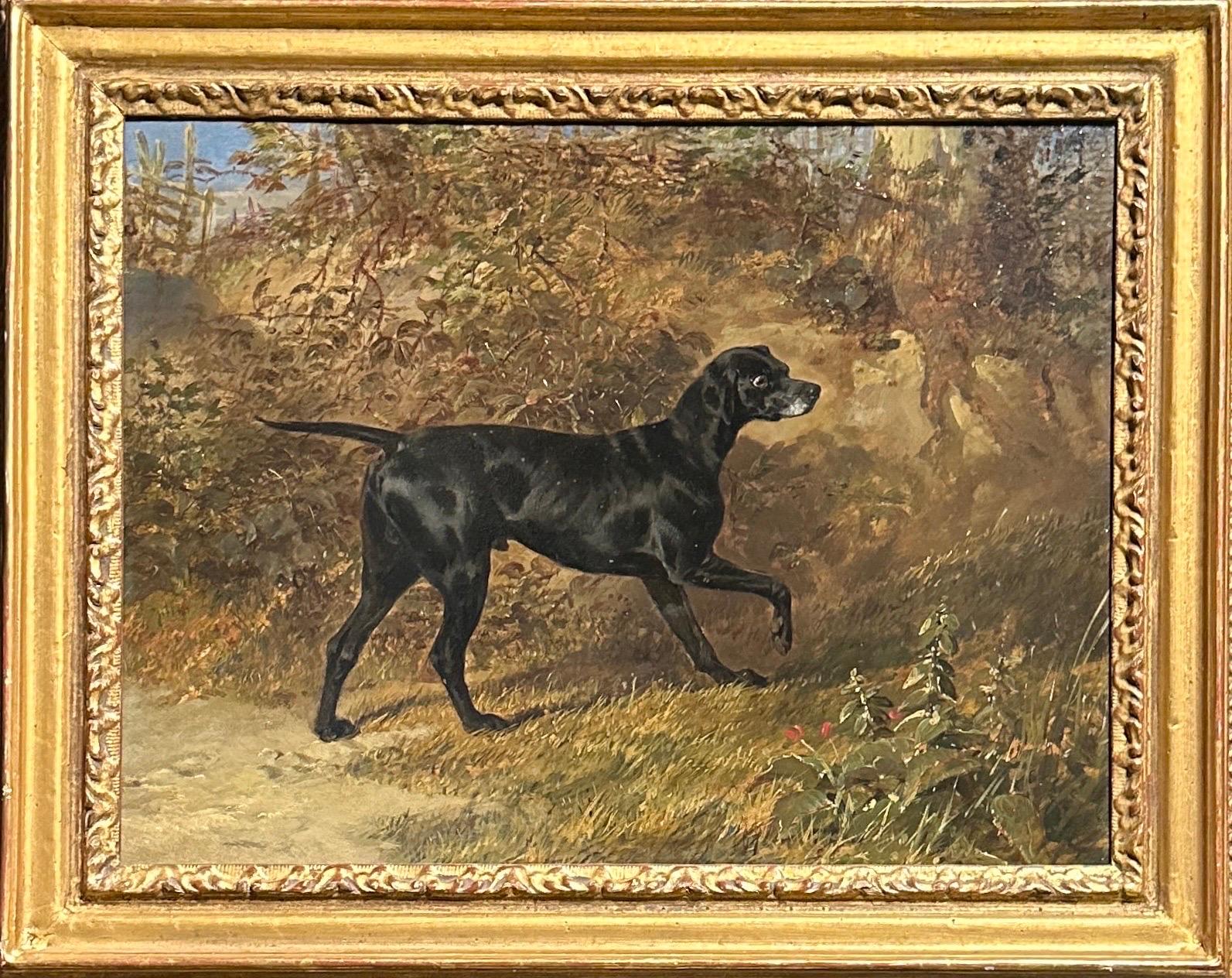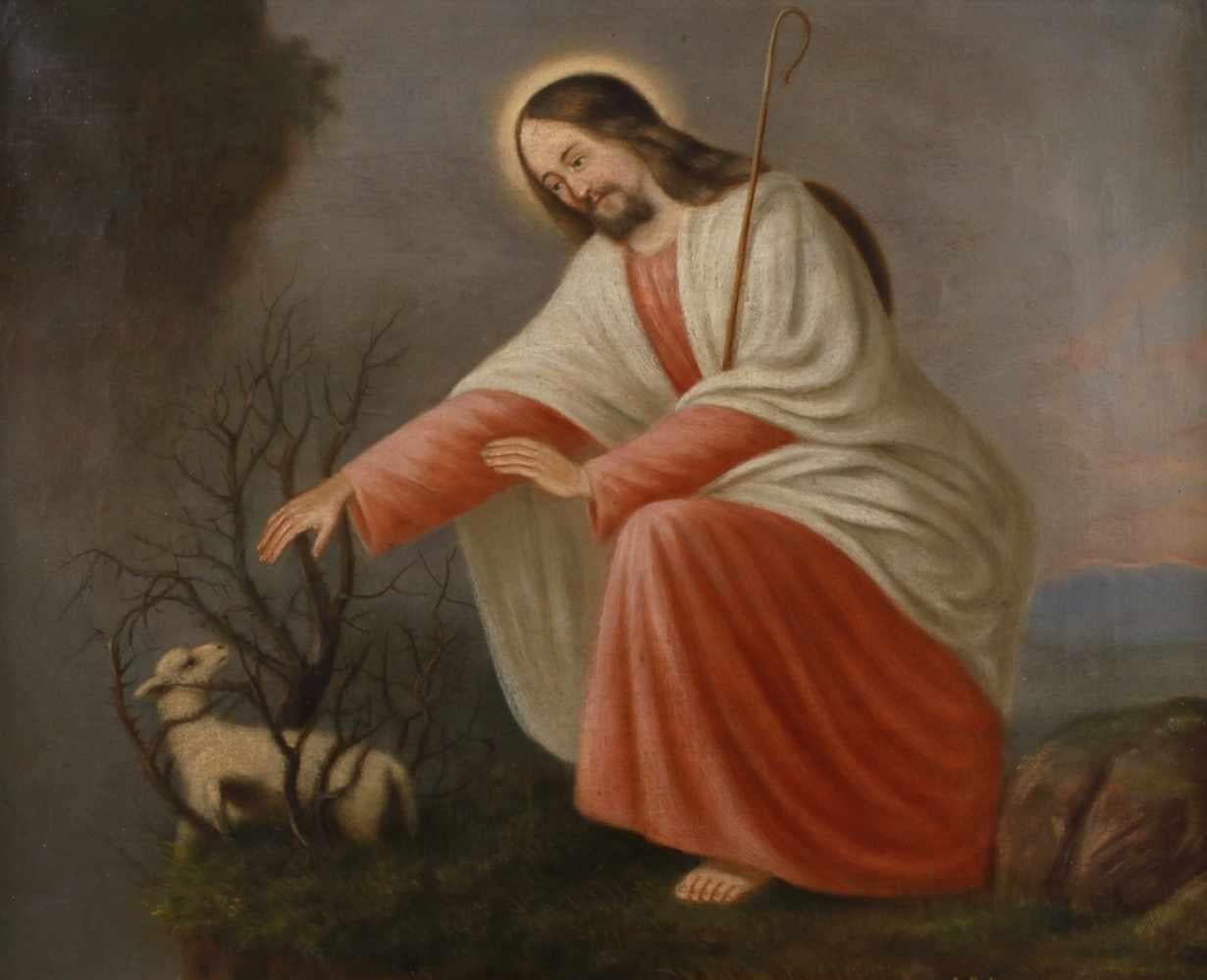Items Similar to Antique 19th century English portrait two Bull Dogs in a yard.
Want more images or videos?
Request additional images or videos from the seller
1 of 12
Antique 19th century English portrait two Bull Dogs in a yard.Circa 1840
Circa 1840
About the Item
A wonderful 19th century portrait of two Bull dogs in a barnyard.
Artist Bio:
Herring was born on 12 September 1795 in Blackfriars, London, the eldest of nine children of Benjamin Herring (d. 1871) and Sarah Jemima (d. 1831), née Howard. His father was a fringe maker and upholsterer working from Newgate Street in the City of London. The Herring family were of Dutch origin and both his father and grandfather, Jan Frederick, pursued unsuccessful claims to the family property in Curaçao. Herring was never apprenticed to his father and hence ineligible to work in the trade. In September 1814 he took the Royal Leeds Union stage and arrived at Doncaster in time to attend the Great St Leger horse race. Lodging in the town, he came upon a coach builder's finishing shop and helped an employee complete the painting of a horse on one of the coaches. The coachbuilder was impressed and asked him to paint the insignia on the Royal Forrester. On the trial run of the latter, he met the proprietor, Mr Hill, and begged of him the vacant post of coachman to the Nelson. He was given the job and followed the arduous profession for six years, ending up on the box of the prestigious High Flyer plying between York and London. Despite working long hours on the stagecoach, the self-taught Herring nonetheless produced a number of surprisingly competent paintings from at least 1815 onwards. Within a year of arriving in Doncaster Herring had set up house with Ann Harris (1796–1838)— no record of their marriage has been found—and had seen the birth of the first of their children, John Frederick junior. His reputation as a sporting painting grew and he developed a following. Among his early patrons were his contemporary Mr (afterward the Revd) Charles Stanhope, a severe critic whose opinion he dreaded; Mr. Clarke of Barnby Moor, owner of the High Flyer; and Mr. Hawkesworth of Hickleton Hall, whose repeated appeals eventually persuaded him to give more time to painting and who found commissions for him from the Hon. E. Petre, Sir Bellingham Graham, and others. Herring's first exhibit at the Royal Academy was A Dog in 1818; in the following year, he had his drawing of the fractured leg of a racehorse reproduced in the Sporting Magazine.
The year 1825 saw the start of the scheme that made him famous. The Doncaster Gazette arranged for him to paint the winners of St Leger from 1815 onwards. The pictures were then engraved and published first by Messrs Sheardown & Son, owners of the Gazette, and subsequently by S. and J. Fuller, and then by Baily Bros. In all, Herring painted thirty-four winners, thirty-one of which were made into prints. A series of twenty Derby winners followed two years later in 1827. 'As a portrayer of the thoroughbred horse in high condition, he is, and long has been unrivaled' (Memoir). By 1830, his fame as a painter of the turf established, Herring moved to Six Mile Bottom, near Newmarket, the headquarters of racing. He stayed there for three years before departing for Camberwell on the outskirts of London. He now had seven surviving children, three of whom became artists: John Frederick junior, Charles (1828– 1856), and Benjamin (1830–1871). Another Benjamin (1806–1830), Herring's brother, was also an artist. Although apparently successful, Herring was in fact in financial difficulties and was rescued by William Taylor Copeland, the owner of the Spode China Company. Copeland paid off his debts of £500, commissioned a number of paintings, and
used Herring'simages of fox-hunting to decorate the company's wares. Ann, aged forty- two, died in 1838 and Herring moved from Park Street to Cottage Green in the same village. He did not totally abandon racing subjects and in 1840 visited France to paint the racehorses of the duc d'Orléans. Further renown came when he was appointed animal painter to the duchess of Kent (Queen Victoria's mother) and received commissions from Queen Victoria. After twenty years in Camberwell, now married to Sarah Gale (1794–1882/3), he moved to the country. He rented Meopham Park near Tonbridge, Kent. In this idyllic refuge, with outbuildings and 30 acres, he soon installed his favourite model, the white Arab Imaum, once given to Queen Victoria, together with other horses, a miniature pony that wandered around the house eating ginger nuts, ten cows, two pigs, geese, peacocks, fowl, duck, rabbits, and two dogs. This Noah's ark of animals soon featured in his immensely popular genre paintings of the farmyard which were no sooner completed than sold to the London dealers. Herring himself had suffered since his youth from asthma and bronchitis. His health now began to deteriorate and for the last few years of his life he was confined to a wheelchair. He continued to send paintings to the British Institution and the Royal Academy until his death. His work was eagerly sought by the increasingly prosperous middle classes. Engravings of over 350 of his paintings were made in his lifetime. Although suspicious that other artists might steal his ideas and apprehensive of forgers, he did collaborate with a number of his contemporaries— James Pollard, A. F. Rolfe, Henry Bright, Sir Edwin Landseer, C. E. Boutibonne, G. B. Campion, John Faed, W. P. Frith—to produce paintings in which he portrayed the animals and the others the background. He exhibited twenty-two pictures at the Royal Academy, eighty-three at the Society of British Artists, and forty-four at the British Institution. Herring died at his home on 23 September 1865 and was buried at Hildenborough, Kent. Examples of his work are in the Tate collection, Doncaster Museum and Art Gallery, many private collections in the UK and the USA
The painting is very fine quality and has all the typical brush strokes of the paintings of Herring. Look closely at how the eyes, the animals bodies and even the fence is painted..typical of Herring.
The painting is framed in a simple antique English frame.
- Attributed to:John Frederick Herring Sr. (1795 - 1865, British)
- Creation Year:Circa 1840
- Dimensions:Height: 12 in (30.48 cm)Width: 14 in (35.56 cm)
- Medium:
- Movement & Style:
- Period:
- Condition:The painting has been cleaned and relined in the UK about 20-30 years ago. It is in good condition and is ready to hang.
- Gallery Location:Woodbury, CT
- Reference Number:1stDibs: LU507311277692
About the Seller
5.0
Platinum Seller
These expertly vetted sellers are 1stDibs' most experienced sellers and are rated highest by our customers.
Established in 1983
1stDibs seller since 2016
404 sales on 1stDibs
Typical response time: <1 hour
- ShippingRetrieving quote...Ships From: Staten Island, NY
- Return PolicyA return for this item may be initiated within 7 days of delivery.
More From This SellerView All
- Late 19th Century English portrait of an English Jack Russell called FritzBy John EmmsLocated in Woodbury, CTEarly 20th Century English portrait of an English Jack Russell, Called Fritz. John Emms was born at Blofield, Norfolk, the son of the artist Henry William Emms. An interest in art took him to London and for some time he worked as Frederick, Lord Leighton...Category
1870s Victorian Animal Paintings
MaterialsCanvas, Oil
- Early 20th century portrait of shire or Clydesdale horses in a landscape.By Edwin Frederick HoltLocated in Woodbury, CTEarly 20th-century portrait in oils of shire or Clydesdale horses in a landscape. Edwin began his artistic career by studying at the Royal Academy of Art where he went on to win a Silver medal for his work at the age of 24. From this point on, his work continued to get recognized and many of his pieces were entered into exhibitions. In total, Edwin Frederick Holt...Category
Early 1900s Victorian Animal Paintings
MaterialsOil, Canvas
- 19th Century English Antique Bay Hunter horse in a stable, called BusinessBy Henry CalvertLocated in Woodbury, CTHenry Calvert was an animal painter, particularly of the sporting variety and best known for his depictions of horses, hunting scenes and equestrian hunting portraits...Category
1840s Victorian Animal Paintings
MaterialsOil, Canvas
- 1935 English oil of a terrier dog portrait, BonzoLocated in Woodbury, CTW.Redworth, English portrait of a terrier dog, circa 1935 Wonderful oil on canvas portrait. A very English animal portrait and a very well painted painting, framed in an amazing a...Category
1930s Victorian Animal Paintings
MaterialsCanvas, Oil
- King Charles Cavalier Spaniel, 19th century English portrait of a dogs headBy George EarlLocated in Woodbury, CT!9th century English portrait of a King Charles Cavalier Spaniel Wonderful portrait study of this very popular breed of dog. Dating from the middle of the 19th century this piece...Category
1860s Victorian Animal Paintings
MaterialsCanvas, Oil
- 19th century English portrait of a horse and setter dog in a stableLocated in Woodbury, CTFritz was an English sporting painter from the middle to latter part of the 19th century. This piece is a classic English sporting paintings...Category
1850s Victorian Animal Paintings
MaterialsCanvas, Oil
You May Also Like
- Head Portrait of a Dog St. Bernard? Antique English Oil Painting on CanvasLocated in Cirencester, GloucestershireSt. Bernard Dog? English artist, late 19th century oil on canvas, framed framed: 19 x 14 inches canvas : 14 x 10 inches provenance: private collection, Wiltshire England condition: v...Category
Late 19th Century Victorian Animal Paintings
MaterialsOil, Canvas
- English 19th century portrait painting of a Pointer dog in a woodland landscapeBy John Frederick Herring Sr.Located in Bath, SomersetA black pointer in a woodland landscape by John Frederick Herring Senior, circa 1830. Oil on canvas in a giltwood frame. Provenance: Arthur Ackerman and Son Frost and Reed Blains, Bruton Place, London John Frederick Herring, born in London in 1795, was the son of a London merchant of Dutch parentage, who had been born overseas in America. The first eighteen years of Herring's life were spent in London, where his greatest interests were drawing and horses. In 1814, at the age of 18, he moved to Doncaster in the north of England, and by 1815, had married Ann Harris. His sons John Frederick Herring Jr., Charles Herring, and Benjamin Herring...Category
1830s Victorian Animal Paintings
MaterialsCanvas, Oil
- The Good Shepherd Antique German Oil Painting on Canvas Christ with LambBy German artistLocated in Cirencester, Gloucestershire"The Good Shepherd" German School, circa 1900 oil painting on canvas, framed canvas: 19.75 x 24 inches framed: 25 x 30 inches Beautiful oil painti...Category
Late 19th Century Victorian Portrait Paintings
MaterialsCanvas, Oil
- Fine Victorian Oil Painting Portrait of Scruffy Terrier Dog Staring in Gilt FrmeLocated in Cirencester, GloucestershireThe Alert Terrier by Martin Theodore Ward (British 1799-1874) oil on canvas, framed framed: 15.5 x 17.5 inches canvas : 10 x 12 inches provenance: private collection, Berkshire, Engl...Category
Mid-19th Century Victorian Animal Paintings
MaterialsOil, Canvas
- Fine Antique German Signed Oil Painting Family of Cats & Kittens, large workLocated in Cirencester, GloucestershireThe Young Family of Cats by Josef Schmitzberger (1851-c.1936) German signed oil on canvas, unframed canvas: 24 x 29.5 inches provenance: private collection, England condition: very g...Category
Late 19th Century Victorian Animal Paintings
MaterialsCanvas, Oil
- Fine Victorian Oil Painting Young Girl with Pet Dog Circular Original 19th cent.Located in Cirencester, GloucestershireHer Favourite Pet Young Lady wearing a straw hat and white dress with blue ribbons with her pet dog. Circle of Arthur John Elsley, British 19th Cen...Category
19th Century Victorian Animal Paintings
MaterialsOil
Recently Viewed
View AllMore Ways To Browse
Art Four Antiques
Antique English Frame
London Dealers
Two Thirty
Antique English Portraits
Animals Dogs
Antique Magazine Art
Animal Leg
Animal Legs
Two Brothers Painting
Contemporary Art In Antique Frame
French Antique Animal
Paintings With Dogs
19th Century English Portraits
Frederick The Great
Two Dogs
All Dogs
Animal Bull
